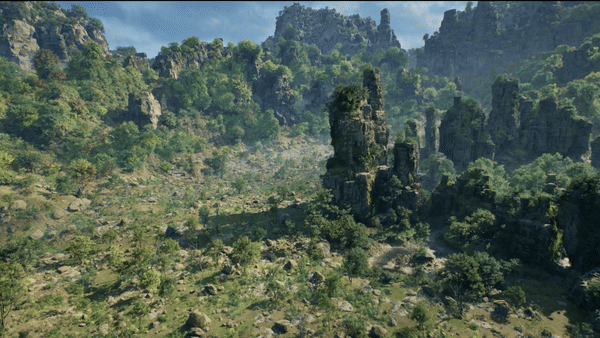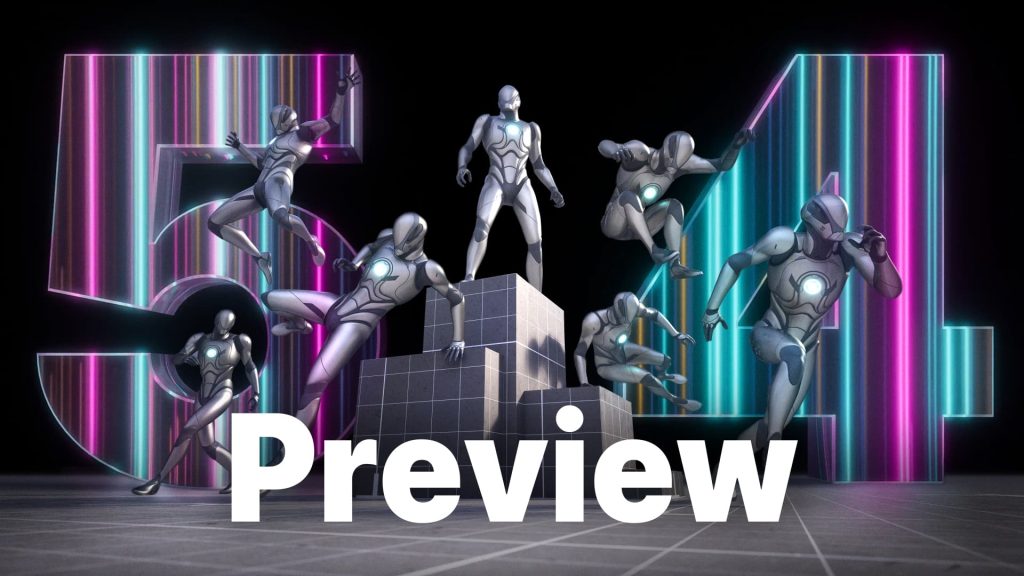With Unreal Engine’s latest release, some big game-changing features have been implemented, replacing traditional world-building methods with streamlined procedural workflows.
Making it more accessible than ever to create rich environments containing highly detailed geometry.
Improving 3D Asset creation and implementation thanks to Nanite and pushing character realism thanks to their MetaHuman Creator tool set.
These tools come at a cost. They require a different way of thinking and planning out these systems, with a new suite of tools might result in having the developers spend time on learning these methods.
What does the current state of Unreal Engine look like?
With Unreal Engine’s latest releases, there is no doubt that the quality of 3D real-time graphics is getting closer to the film industry.
Facilitating accessibility and reducing the time investment required for Digital Twin projects, with the capability of rendering at runtime, opening a window for techniques such as Virtual Production.
Unreal 5.4, what does it bring to the table?
Within Cradle’s recent projects which focus on Digital Twins, there has been an overall need for cinematic and realistic graphics, thus benefiting from all the new improvements of Unreal’s Nanite and Lumen real-time global illumination features, which are being improved in each release.

Optimizing their Nanite shader model has been an ongoing task for Epic since it was introduced in Unreal Engine 5.0, with the goal being a full replacement of their traditional shading models;
“The ultimate goal is to fully replace the pixel shader path in its entirety, offering increased performance on both CPU and GPU, improve code maintainability, and also make it possible to implement advanced Nanite material functionality that would not be otherwise possible.”
Nathaniel Morgan (2023)
Nanite Tessellation
Tessellation was removed with the release of 5.0 since Nanite was still under development and did not support this feature, this was used in Unreal 4.26 for a wide variety of things, like adding extra detail to geometry using vertex displacement provided by displacement maps; Landscape materials and clothing materials were are of the many examples that would previously benefit from tessellated geometry by adding an extra layer of micro detail on a geometry level.
Having adaptive tessellation for meshes with Nanite is a feature that would benefit some in-house projects like Procedural Ocean; allowing their generated landscapes to blend between different types of soils with an extra notch of controllable parameters that could be tweaked at runtime, making it possible to have higher detail when the player gets closer to the landscape. This in combination with the Nanite Landscape support released in their 5.3 will be a must for feature projects requiring terrain generation.
Nanite support for Spline Meshes
This is a nice added benefit to the 5.4 release, for games that need spline visualizations.
Allowing to place 3D geometry along a spline and deforming it based on the line’s shape, using Nanite rendering, all editable in real-time.
Static and Skeletal Mesh Editor
Introducing bone weight painting in the editor is a valuable feature that enables artists on teams to conveniently adjust and repair skeletal meshes after importing them into Unreal. Additionally, they’ve made enhancements to various regular modeling tools, including bevel and extrude functions, and have iterated on their UV editing tool.

They are also incorporating a new modular control rig structure, which makes it simple to set up any skeleton. The framework is easily adaptable straight out of the box due to its incorporation of native modules and libraries.

Motion Matching System
“Motion Matching becomes Production Ready in Unreal Engine 5.4. It ships with a suite of tools offering animator-centric workflows for gameplay animation. Unreal Engine’s Motion Matching has been validated on Fortnite Chapter 5, shipping on all platforms thanks to the scalability of the system.”
Paddy Walker (2023)
With it they include over 500 AAA animations created from high-end motion capture data with the locomotion and traversal dataset, the animations are fully integrated with their control rig system and editable in the sequencer.

Having access to this big animation library will benefit projects that involve humanoid characters or native MetaHuman characters.
Recent projects in Cradle like VIBE and MAI involve high-fidelity human characters, having these animations available would add some great value for future projects that will need character animations.
Niagara fluids
On the VFX side, some nice Niagara systems are getting improved and integrated such as:
- 2D Liquids – Improved surfacing and rendering
- 2D Gas – FFT-based pressure solver and cubic interpolation
- 3D Gas/Liquids – High precision boundary conditions with finite volume method
- 3D Liquids – 2-way coupled simulation with GPU particles
- 2D Gas – Caching support
Allowing the VFX artists to get better smoke and water visuals, these being of high value for in-house projects like Procedural Ocean, that benefit from high-fidelity water effects.

PCG (Procedural Content Generation) Improvements
Procedural Content Generation is one of the biggest features implemented so far and they keep improving it.
Adding features like; runtime hierarchical support, dynamic attribute tracking, and new native PCG nodes and operations.
All this allows to generate and populate large worlds with procedural systems, being suitable for digital twin projects that try to replicate large environments, like Procedural Ocean.
Enhancing the experience of art directing large environments.

Virtual Productions
Updates to Unreal Engine’s Virtual Camera tool, which is now Production-Ready and adds Android to its compatibility list. Additionally, Unreal Engine will now fully support virtual camera workflows with the Unreal VCam app.
For ICVFX, a new depth-of-field compensation feature is added. Calculating the distance between the camera and the screen accurately compensates for the offset between the physical and virtual worlds.

Final Thoughts
For Cradle’s projects, Unreal Engine 5.4 provides a number of benefits that make it a valuable asset for our team.
The use of cutting-edge tools like Nanite and the MetaHuman Creator may significantly improve the realism and quality of our digital models and character designs, enhancing and saving a significant amount of time during the development process.
For our digital twin projects, the enhanced visual effects capabilities and procedural content creation tools are extremely beneficial in producing detailed and appealing environments.
Unreal Engine 5.4 brings a lot of powerful new features to the table, equipping us with the tools necessary to keep pushing the quality of our projects.

